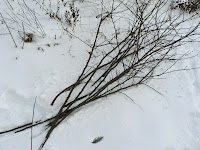Saturday, January 15, 2011
fixing the defects
Maiolica glaze does not move and heal during the firing process, and , in addition, because there is such a clear difference between glaze color (white), and clay body (red), things such as finger marks are very obvious and not well integrated into the whole after the glaze has been fired. Part of this is the fact that I fire in an electric kiln. I've often thought that firing in an electric kiln is a lot like cooking vegetarian. As an omnivore, it seems that one could simply throw a chunk of meat, along with veggies, into a pot and put it into the oven for an hour or so, and have a tasty meal, one whose flavorings were enhanced by the meat and its fat and juices. Being vegetarian (or using an electric kiln) means you have to be smart up front. Everything is in the preparation before the work goes into the oven (kiln). I remember Richard Zakin telling us about how to fire electric kilns and get good effects. You had to know about the clay body, and the glaze, and the colorants, and you had to use that knowledge before you ever got to the firing process. So, here are some examples of potential surface problems which, if left, would turn up, again, after the firing: pinholes (on the edge of a yunomi), and fingermarks--you can see the whorls of my fingerprint, and drips--on the waxed foot, and a small area that escaped being glazed. I will take the back of my fingernail and flatten the pinhole, then paint more glaze over it. The glaze for repair has been thinned somewhat with a mixture of cmc gum (helps with the flow) and macloid (keeps it from settling)--- (this is a Walter Ostrom technique which I also use to mix the colorants). Then I will smooth the edge of the platter that has my fingerprints, and paint more glaze over the bare spaces, feathering the 'patching' glaze into the main body of glaze. I'll then take a sponge and wipe the drips off of the waxed foot, and fill in the unglazed area (which shows the red of the clay body). It will take me several days to re-finish all of the pots that I want to decorate for the next kiln load. Sometimes the best time to see all the defects is late in the day when the sun is coming in the west windows of the studio---and lays long shadows over the glazed pots I'm working on. The defects--drips, and pinholes, sometimes hard to see in direct light--show up better.
Wednesday, January 12, 2011
winter snow

 The white snow outside and the white glaze inside the studio --- a sympathetic, seasonal coloration. I've unloaded one bisque kiln and am loading up another. The pieces from the first kiln have been dipped into water, and then glaze, and now need to be gone over in detail to fix the pinholes and fingermarks and drips. It's probably my least favorite of all of the processes and I often find other jobs to do, just to get out of the studio and avoid the fixing part. This afternoon, after I went skiing, I pruned some of the sucker branches from an old crab apple tree. I have an idea for a plate holder, and I think I can use the branches as side pieces, instead of dowels. And, now, in another clever avoidance technique, I'm working on the blog instead of on the glaze.
The white snow outside and the white glaze inside the studio --- a sympathetic, seasonal coloration. I've unloaded one bisque kiln and am loading up another. The pieces from the first kiln have been dipped into water, and then glaze, and now need to be gone over in detail to fix the pinholes and fingermarks and drips. It's probably my least favorite of all of the processes and I often find other jobs to do, just to get out of the studio and avoid the fixing part. This afternoon, after I went skiing, I pruned some of the sucker branches from an old crab apple tree. I have an idea for a plate holder, and I think I can use the branches as side pieces, instead of dowels. And, now, in another clever avoidance technique, I'm working on the blog instead of on the glaze.
Subscribe to:
Posts (Atom)




